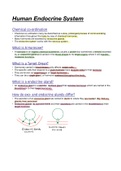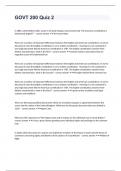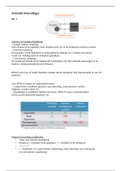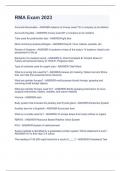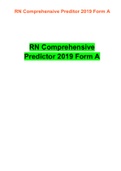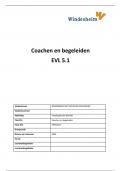Scientific Method: Lecture 1
Characteristics of Science
• Based on empirical knowledge
◦ knowledge derived from observation or experimentation
‣ data collection (quantitative or qualitative)
◦ observations - often the starting point of a scientific investigation
• Provides rational/natural explanations
◦ seeking explanations in terms of rational/natural causes
◦ very few questions are off-limits in science - but the answers science can provide are limited to
the natural world
• Repeatable and reproducible (and reliable)
◦ scientific results are always subject to confirmation by the same or other investigators
‣ makes the study more reliable/powerful
◦ if experiments can be repeated/reproduced via a reliable method/procedure -> confirmation ->
reliable findings
◦ sometimes due to impracticality, temporal difficulties, or expense, it's not possible to repeat/
reproduce experiments
• Testable
◦ a good theory isn't enough - must be testable via experiments
◦ for an idea to be testable, it must generate specific expectations
‣ a set of observations/results are expected if idea true
‣ same expected if false
◦ sometimes to test ideas, the development of new tools may be required
• Involves experimentation
◦ an organized and detailed series of steps to validate or reject a hypothesis
• Generality of principles
◦ science seeks generality of principles
‣ generality is the establishment of universal principles that express how the natural world
works under certain conditions
The Scientific Method
1. define/identify a problem/question (usually arises from observation)
2. formulate a hypothesis (a potential explanation)
3. test the hypothesis - make observations or perform experiments and collect data
4. analyze data/results
5. does the data support the hypothesis? - if no, make new hypothesis/experiments
6. draw conclusions
7. communicate results
Case Study: Human Chromosome Count
• in 1923, Theophilus Painter reported that there were 48 chromosomes in a human cell
◦ had serial sections of testicular cells in metaphase and chromosomes were clumped together
and curled in
• this number was believed and accepted for 33 years - scientists used the same technique he used to
experiment
,• in 1950's new techniques were used such as hypotonic treatment, treatment with colchicine and
ideograms to count chromosomes
◦ 1952 - Tijo and Levan reported 46 chromosomes
• so what was wrong with Painter's approach? - he was only working with samples from a single patient
◦ we don't know if he had any chromosome aberrations
◦ single chromosome could have been counted as 2
• people often see what they expect/want to see - this is bias
Scientific Method: Lecture 2
Reasoning
Inductive Deductive
• inductive: summarizes a set of observations and
serves to provide predictions about unseen
events
◦ Ex. this ice is cold, therefore ALL ice is cold
• deductive: going beyond formulation of
hypotheses formed by induction & test if correct
◦ Ex. if all green apples are sour, then this
green apple will be sour
The Hypothesis
• statement or idea proposed as tentative explanation to a research question and the account for
observations
◦ question -> hypothesis -> prediction -> experiment
• should be:
◦ simple
◦ specific
◦ stated in advance
• it leads to predictions about the result of intervention
Testing the Hypothesis
• the formulation and testing of hypothesis is the basis of any scientific or rational inquiry
• deductive syllogism: hypothesis followed by a prediction
◦ i.e. "If (hypothesis) ..., then (prediction)
• Ex. hypothesis: all swans are white
◦ prediction: swans that live in America should be white
◦ If all swans are white, American swans should also be white
Prediction and Hypothesis Testing
• predictions can be verified or refuted by analyzing the data
◦ accumulation of supporting experimental evidence (i.e. consistent with your prediction) will
strengthen a hypothesis but will never let us know for certain that the hypothesis is true
‣ therefore, you fail to reject the hypothesis
◦ a contradictory observation to your prediction (i.e. if the results you obtain are inconsistent
, with your prediction) allow us to know for (almost) certain that a hypothesis is incorrect
‣ therefore you reject the hypothesis
Null vs Alternative Hypothesis
• Null hypothesis (H0): usually a statement of 'no effect' or 'no difference'
◦ a hypothesis that there is no significant different between two sets of results, e.g.:
‣ between observations from a control group and experimental group
‣ between observations of two groups in two different conditions
‣ between a set of predicted results and the observed results
• Alternative hypothesis (Ha): hypothesis that is contrary to the null hypothesis
◦ usually the research hypothesis
◦ this is the hypothesis that you are trying to
'prove'
• as seen in the table, a type I error is one in which the BoB
null hypothesis is rejected, but in reality we should
have failed to reject
• a type II error is one in which we fail to reject the null
when we should have rejected it
Case Study: Brain Freeze
• Ha: the rate at which you eat ice cream affects whether you will experience an ice cream headache
• Ho: there is no effect of the rate of eating ice cream on the incidence of ice cream headaches
◦ i.e. there is no statistical difference in either observed effects (they both either cause headaches
or they don't)
• The experiment: 145 middle school students were randomly placed into 2 groups:
◦ Eat slowly group: eat ice cream in over 30 seconds (100mL)
◦ Eat fast group: eat it in 5 seconds (100mL)
• Results: found that in slow group, 9% had headaches whereas fast group 27% has headaches
◦ a chi-square test can be done to see if these values are statistically significant
• Drawing conclusions:
◦ if researchers rejected the Ho: data supports Ha or is consistent with the Ha
◦ if failed to rejected the Ho: they didn't detect a difference between groups and there is no
evidence to support Ha
‣ this basically means they accepted the null hypothesis
Characteristics of Science
• Based on empirical knowledge
◦ knowledge derived from observation or experimentation
‣ data collection (quantitative or qualitative)
◦ observations - often the starting point of a scientific investigation
• Provides rational/natural explanations
◦ seeking explanations in terms of rational/natural causes
◦ very few questions are off-limits in science - but the answers science can provide are limited to
the natural world
• Repeatable and reproducible (and reliable)
◦ scientific results are always subject to confirmation by the same or other investigators
‣ makes the study more reliable/powerful
◦ if experiments can be repeated/reproduced via a reliable method/procedure -> confirmation ->
reliable findings
◦ sometimes due to impracticality, temporal difficulties, or expense, it's not possible to repeat/
reproduce experiments
• Testable
◦ a good theory isn't enough - must be testable via experiments
◦ for an idea to be testable, it must generate specific expectations
‣ a set of observations/results are expected if idea true
‣ same expected if false
◦ sometimes to test ideas, the development of new tools may be required
• Involves experimentation
◦ an organized and detailed series of steps to validate or reject a hypothesis
• Generality of principles
◦ science seeks generality of principles
‣ generality is the establishment of universal principles that express how the natural world
works under certain conditions
The Scientific Method
1. define/identify a problem/question (usually arises from observation)
2. formulate a hypothesis (a potential explanation)
3. test the hypothesis - make observations or perform experiments and collect data
4. analyze data/results
5. does the data support the hypothesis? - if no, make new hypothesis/experiments
6. draw conclusions
7. communicate results
Case Study: Human Chromosome Count
• in 1923, Theophilus Painter reported that there were 48 chromosomes in a human cell
◦ had serial sections of testicular cells in metaphase and chromosomes were clumped together
and curled in
• this number was believed and accepted for 33 years - scientists used the same technique he used to
experiment
,• in 1950's new techniques were used such as hypotonic treatment, treatment with colchicine and
ideograms to count chromosomes
◦ 1952 - Tijo and Levan reported 46 chromosomes
• so what was wrong with Painter's approach? - he was only working with samples from a single patient
◦ we don't know if he had any chromosome aberrations
◦ single chromosome could have been counted as 2
• people often see what they expect/want to see - this is bias
Scientific Method: Lecture 2
Reasoning
Inductive Deductive
• inductive: summarizes a set of observations and
serves to provide predictions about unseen
events
◦ Ex. this ice is cold, therefore ALL ice is cold
• deductive: going beyond formulation of
hypotheses formed by induction & test if correct
◦ Ex. if all green apples are sour, then this
green apple will be sour
The Hypothesis
• statement or idea proposed as tentative explanation to a research question and the account for
observations
◦ question -> hypothesis -> prediction -> experiment
• should be:
◦ simple
◦ specific
◦ stated in advance
• it leads to predictions about the result of intervention
Testing the Hypothesis
• the formulation and testing of hypothesis is the basis of any scientific or rational inquiry
• deductive syllogism: hypothesis followed by a prediction
◦ i.e. "If (hypothesis) ..., then (prediction)
• Ex. hypothesis: all swans are white
◦ prediction: swans that live in America should be white
◦ If all swans are white, American swans should also be white
Prediction and Hypothesis Testing
• predictions can be verified or refuted by analyzing the data
◦ accumulation of supporting experimental evidence (i.e. consistent with your prediction) will
strengthen a hypothesis but will never let us know for certain that the hypothesis is true
‣ therefore, you fail to reject the hypothesis
◦ a contradictory observation to your prediction (i.e. if the results you obtain are inconsistent
, with your prediction) allow us to know for (almost) certain that a hypothesis is incorrect
‣ therefore you reject the hypothesis
Null vs Alternative Hypothesis
• Null hypothesis (H0): usually a statement of 'no effect' or 'no difference'
◦ a hypothesis that there is no significant different between two sets of results, e.g.:
‣ between observations from a control group and experimental group
‣ between observations of two groups in two different conditions
‣ between a set of predicted results and the observed results
• Alternative hypothesis (Ha): hypothesis that is contrary to the null hypothesis
◦ usually the research hypothesis
◦ this is the hypothesis that you are trying to
'prove'
• as seen in the table, a type I error is one in which the BoB
null hypothesis is rejected, but in reality we should
have failed to reject
• a type II error is one in which we fail to reject the null
when we should have rejected it
Case Study: Brain Freeze
• Ha: the rate at which you eat ice cream affects whether you will experience an ice cream headache
• Ho: there is no effect of the rate of eating ice cream on the incidence of ice cream headaches
◦ i.e. there is no statistical difference in either observed effects (they both either cause headaches
or they don't)
• The experiment: 145 middle school students were randomly placed into 2 groups:
◦ Eat slowly group: eat ice cream in over 30 seconds (100mL)
◦ Eat fast group: eat it in 5 seconds (100mL)
• Results: found that in slow group, 9% had headaches whereas fast group 27% has headaches
◦ a chi-square test can be done to see if these values are statistically significant
• Drawing conclusions:
◦ if researchers rejected the Ho: data supports Ha or is consistent with the Ha
◦ if failed to rejected the Ho: they didn't detect a difference between groups and there is no
evidence to support Ha
‣ this basically means they accepted the null hypothesis

